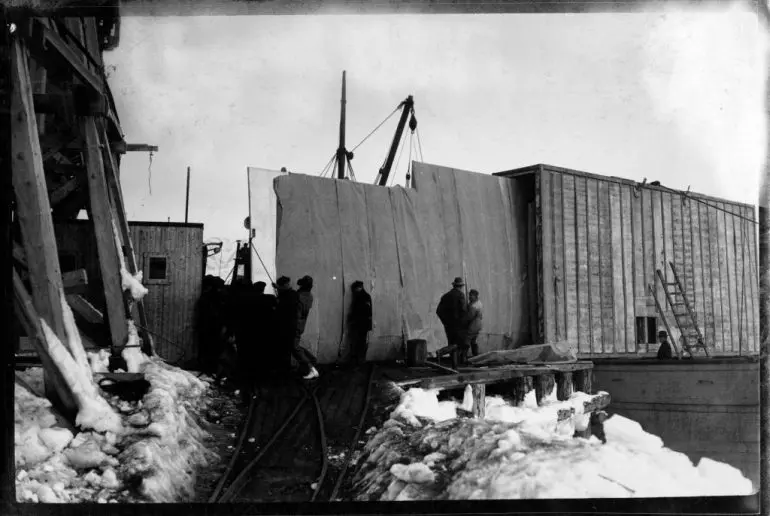Roald Amundsen, a name synonymous with polar exploration, stands tall in the annals of history as a testament to human resilience and the unyielding desire to discover.
Born in 1872 in Norway, the future explorer Roald Amundsen was brought up surrounded by rugged landscapes and a rich seafaring tradition which shaped his destiny as one of the greatest explorers of all time.
Amundsen’s entry into exploration began with numerous voyages that sharpened his skills and intensified his enthusiasm for discovery. Among these, he joined the esteemed explorer Adrien de Gerlache on the Belgian Antarctic Expedition. Notably, Amundsen later achieved what many seasoned mariners had failed for centuries: he became the first to navigate the Northwest Passage. Additionally, he embarked on a historic race to the South Pole against Robert Scott. Ultimately, reaching the South Pole first marked the pinnacle of his illustrious career.
Tragically, his ultimate fate was shrouded in mystery with his disappearance in 1928 while on a rescue mission in the Arctic. This enigmatic end to his life has since become a part of the legend of Roald Amundsen, leaving an indelible mark on his history of adventure and exploration and igniting the imagination of future generations.
This is the truly remarkable story of the explorer Roald Amundsen.
The Early Life of Roald Amundsen

Borge, Norway (Credit: steinliland via Getty Images)
Born to Jens Amundsen and Hanna Sahlqvist in the southern Norwegian town of Borge on July 16, 1872, Roald Engelbregt Gravning Amundsen was destined for a life at sea. His family were shipowners and captains, though it’s said that his mother urged him to forgo a life on the open waves and become a doctor.
As a teenager he would read stories of British Arctic explorer Sir John Franklin – who made an unsuccessful attempt to traverse the Northwest Passage in 1845 – and he later wrote ‘I read them with a fervid fascination which has shaped the whole course of my life.’ One story often told about his childhood – although it may be apocryphal – was that he slept with his bedroom windows wide open, even in the brutal Norwegian winters, to condition himself for life in some of the most extreme conditions known to humankind.
He did indeed study medicine for a time, but when his mother died in 1893 when Amundsen was 21, he left university and started an astonishing career exploring some of the most remote and inhospitable parts of the planet.
The Belgian Antarctic Expedition

Men at work during Amundsen's Antarctic expedition (Credit: Mondadori Portfolio / Contributor via Getty Images)
The Amundsen expeditions started on a thirty-six metre research ship named Belgica under the command of Baron Adrien Victor Joseph de Gerlache de Gomery, known as Adrien de Gerlache. Gerlache was a Belgian navy officer who led the 1897 – 1899 Belgian Antarctic Expedition.
The expedition – generally accepted to be the start of what became known as the Heroic Age of Antarctic Exploration – was the first in history to spend the winter in Antarctica when the ship, whether by accident or design, got locked inside the sea ice close to Alexander Island, west of the Antarctic Peninsula.
When the expedition successfully returned to Antwerp in Belgium, they were warmly welcomed, but as an explorer, Amundsen was just getting started.
The Northwest Passage

Admundsen (second-right) at Horten Navy Yard (Credit: Bettmann / Contributor via Getty Images)
In 1903, Roald Amundsen set out from Oslo on one of the most daring voyages of his career, aiming to traverse the elusive Northwest Passage. This treacherous sea route through the Arctic Archipelago connects the Atlantic and Pacific Oceans, a pathway that had captivated – and eluded – the world’s greatest explorers for centuries.
With an experienced crew of six aboard a refitted 40-tonne fishing sloop called Gjøa, Amundsen set sail on June 16, 1903.
The expedition through the Northwest Passage proved to be an arduous test of endurance and navigational skill. Amundsen and his crew faced extreme cold, ice-choked waters, and the constant threat of starvation and scurvy. Despite these challenges, the intrepid explorer Amundsen’s adept leadership, his respect for and learning from the local Inuit people’s survival techniques, and the crew’s relentless perseverance, ultimately led them to success.
After over three years, including months stuck in the ice and two winters spent in the Canadian Arctic learning from the Inuit, the Gjøa emerged into the Pacific Ocean in August 1906, marking the first successful navigation of the Northwest Passage.
This monumental achievement not only brought Roald Amundsen significant fame but also proved instrumental in shaping polar exploration tactics and survival strategies in the years to follow.
The South Pole

The South Pole expedition led by Roald Amundsen. (Credit: Mondadori Portfolio / Contributor via Getty Images)
For Amundsen, South Pole success was to be his crowning glory. He had originally planned to conquer the North Pole but in 1909 news reached him that American explorers Frederick Cook and Robert Peary both claimed – in separate expeditions – to have reached the North Pole, so he set his sights south.
On the 39-metre schooner Fram, Amundsen, with Helmer Hanssen, Sverre Hassel, Oscar Wisting and Olav Bjaaland, plus a shore crew of fourteen, set out in June 1910.
Knowing Captain Robert Falcon Scott was also planning an expedition to the South Pole, Amundsen sent Scott a telegram which read ‘Beg to inform you Fram proceeding Antarctic – Amundsen.’
Roald Amundsen established his base camp, which he named ‘Framheim,’ in the Bay of Whales on the Ross Ice Shelf. His meticulous planning, expertise in ski travel, and use of sled dogs gave his team a significant advantage. They embarked on their final push to the pole on October 19, 1911. Amundsen’s strategy emphasised speed and efficiency, and his deep understanding of cold-weather survival techniques, learned from the Inuit people, played a crucial role in his team’s progress.
After an arduous trek in brutal conditions, on December 14, 1911, Roald Amundsen, along with Hanssen, Hassel, Wisting and Bjaaland, became the first people to reach the South Pole, a month before Captain Scott arrived. To ensure their achievement was recorded, should they not return, Amundsen’s team left behind a tent, a Norwegian flag, and a letter. This letter declared their monumental feat: being the first people in human history to reach the South Pole.
The five men returned safely to Framheim, having traversed the icy expanse without loss of human life. In contrast, Scott’s expedition, which reached the pole over a month later on January 17, 1912, ended in tragedy. Scott and his four companions perished on the return journey.
The stark differences in the outcomes of these two expeditions were attributed to their contrasting approaches to planning, equipment, and understanding of the polar environment.
World-famous explorer Roald Amundsen’s triumph at the South Pole not only marked a significant milestone in polar exploration, but also highlighted the critical importance of his approach to preparation and adaptability in extreme conditions.
The North Pole

1925, Roald Amundsen's expedition to the North Pole (Credit: Photo 12 / Contributor via Getty Images)
After an aborted attempt to traverse the Northeast Passage in 1918, he took a final curtain call in the mid-1920s. The Amundsen expeditions ended with the first verified flight over the North Pole.
In 1926, a team comprising Roald Amundsen, American polar explorer Lincoln Ellsworth, Hjalmar Riiser-Larsen – regarded as the founder of the Royal Norwegian Air Force – Oscar Wisting, who went to the South Pole with Amundsen fourteen years previously, and fifteen aircrew, became the first people to cross the Arctic and fly over the North Pole.
They flew in a semi-rigid airship called the Norge, piloted by Italian aeronautical engineer Umberto Nobile. They left Spitsbergen on May 11, 1926 and flew over the North Pole the following day. They landed in Alaska on the 13th.
This historic flight not only added a significant chapter to the history of polar exploration but also demonstrated the potential of aviation in exploring and understanding some of the most remote and inaccessible regions of the Earth.
The North Pole Controversy

Amundsen's hydroplane N-25 flying over the Oslo fjord (Credit: Photo12/UIG via Getty Images)
Prior to Amundsen’s successful – and verified – flight over the North Pole, there had been three claims by three different men who said they had been to the North Pole. Americans Frederick Cook in 1908, Robert Peary a year later, and Richard E. Byrd supposedly just days before Amundsen and his team.
Each of these three claims has been disputed in one way or another, either for genuine geographical inaccuracy or, as some have suggested, outright fraud. If indeed none were ultimately successful, Amundsen and Wisting were the first men to reach both the North and South Poles.
Roald Amundsen’s Final Flight

Nobile's ill-fated semi-rigid N-class airship N1 'Italia' (Credit: Pictorial Parade / Staff via Getty Images)
In June 1928, Umberto Nobile’s airship, Italia, crashed on route back from the North Pole. Amundsen, along with Norwegian pilot Leif Dietrichson and French pilot René
Guilbaud went to look for Nobile and his crew in a twin-engined Latham 47 flying boat. The Latham would never return from the search.
A section of a wing and a petrol tank were found in the Barents Sea off the northern Norwegian coastal town of Tromsø and it’s assumed that Amundsen’s plane crashed and the passengers killed.
A search of the area was conducted, but by September 1928 the effort was called off. Two further attempts to locate the wreckage took place in 2004 and again in 2009 using unmanned submersibles but again, nothing was found.
An Extraordinary Explorer: Amundsen’s Legacy

Amunden (centre) at home in Svartskog near Oslo (Credit: Bettmann / Contributor via Getty Images)
The legacy of Roald Amundsen as a truly remarkable polar explorer is a narrative of courage, innovation, and an unquenchable thirst for discovery. From the groundbreaking navigation of the Northwest Passage and his victorious race to the South Pole against Scott, to his ambitious – albeit ultimately unsuccessful – journey through the Northeast Passage and pioneering flight over the North Pole, Amundsen’s feats remain unmatched in the annals of exploration.
His meticulous planning, respect for indigenous knowledge, and adaptability in the face of the harshest environments set new standards in exploration and have inspired generations. The mystery surrounding his disappearance in 1928 only adds to the legend of this extraordinary explorer. Roald Amundsen’s enduring legacy is not just in the records he set or the territories he charted, but in the pure spirit of exploration.












